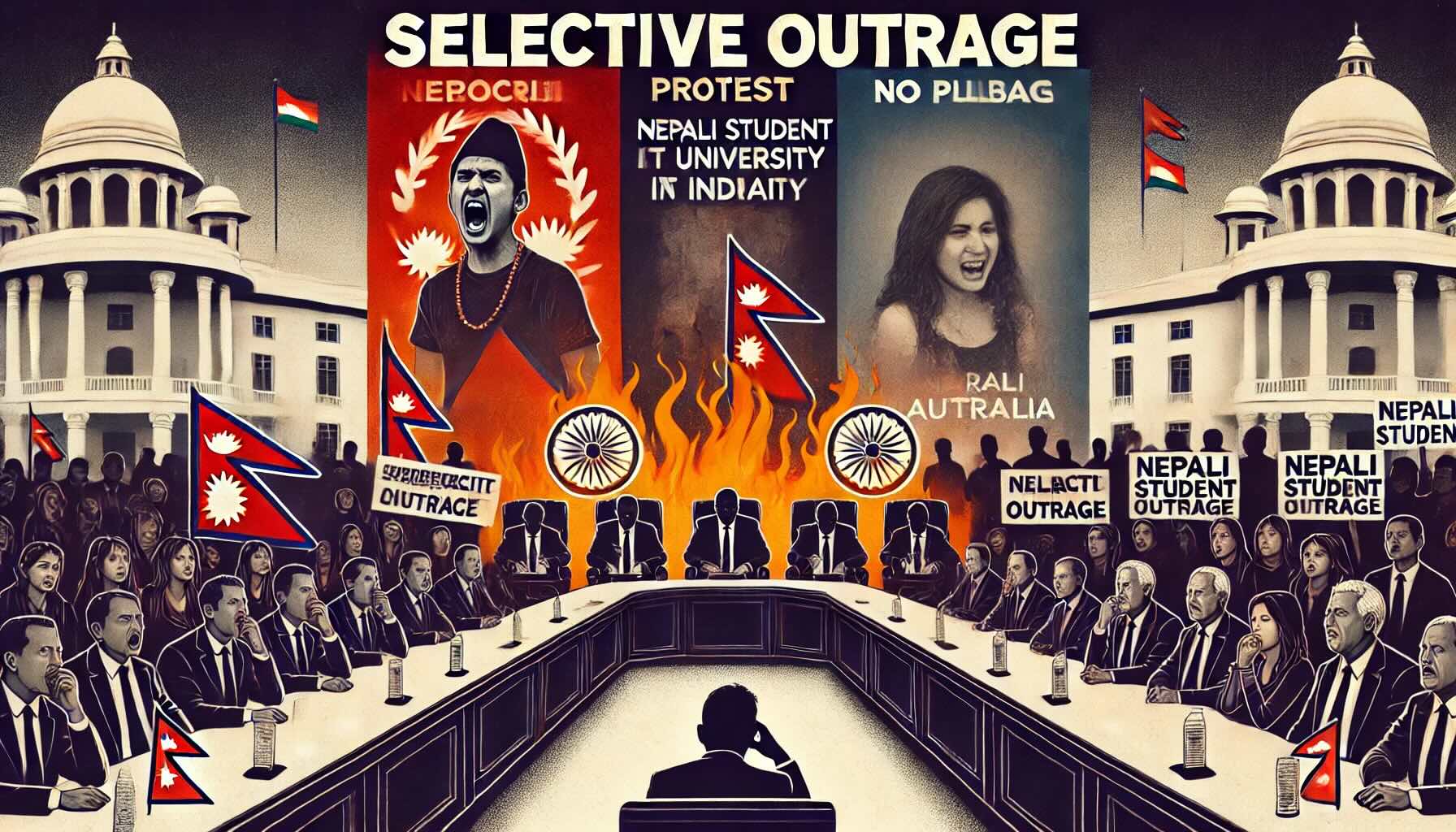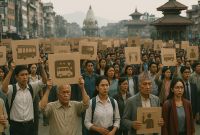Selective Outrage: The Hypocrisy of Nepali MPs and Protesters Exposed

In recent months, multiple tragic deaths of Nepali citizens abroad have gone unnoticed by Nepal’s political elite and so-called activists. A Nepali girl was shot dead in the United States. Another Nepali woman was found lifeless in Australia under suspicious circumstances. Yet, these incidents failed to trigger protests, political statements, or media scrutiny. The silence was deafening.
In stark contrast, the alleged suicide of a Nepali student at Kalinga Institute of Industrial Technology (KIIT) in India ignited a firestorm of outrage. Almost overnight, student activists, social media influencers, and politicians erupted in protest, marching toward the Indian Embassy, burning Indian flags, and amplifying an anti-India narrative. The selective nature of these reactions raises a crucial question: Why do Nepali lives only seem to matter when lost in India?
This pattern of outrage exposes a deep-rooted bias in Nepal’s political and activist circles, where responses to the deaths of Nepali citizens abroad are dictated not by the need for justice but by the political convenience of the narrative.
Nepali Students: Selective Outrage at Its Worst
The protests over the KIIT incident were swift, aggressive, and well-organized. Within hours of the student’s death, crowds gathered in front of the Indian Embassy in Kathmandu, social media was flooded with nationalist slogans, and university groups began calling for diplomatic action. Yet, when a Nepali woman was murdered in Australia, there was no such coordinated response. When a Nepali student was shot dead in the United States, not a single protest erupted outside the U.S. Embassy.
This stark contrast highlights a troubling reality: Nepal’s student movements are not driven by a genuine concern for justice but by a selective agenda. The reason is simple—protesting against India is politically convenient. It aligns with a long-standing anti-India sentiment that certain groups in Nepal have actively nurtured. Western countries, on the other hand, do not face the same level of hostility, making it politically unviable for student leaders to mobilize outrage against them.
If Nepali student organizations truly cared about the safety and dignity of Nepali citizens abroad, they would demand justice in all cases, regardless of the country involved. Instead, their selective activism exposes an inherent hypocrisy where national pride is invoked only when it serves a populist agenda.
Nepali MPs: Loud Against India, Silent Elsewhere
While student protesters demonstrated selective activism, Nepali politicians displayed their own brand of calculated outrage. As soon as the KIIT incident came to light, MPs issued statements condemning India’s treatment of Nepali students, questioning the security of Nepali citizens studying in Indian institutions, and demanding swift action. The Prime Minister even dispatched officials to Odisha to investigate the matter.
But where was this urgency when a Nepali student was murdered in the U.S.? Why was there no similar parliamentary debate when a Nepali woman’s body was discovered in Australia? In those cases, no Nepali MP bothered to demand an inquiry. No government official was sent to engage with U.S. or Australian authorities. There was no diplomatic pressure, no emergency meetings—just silence.
This glaring inconsistency reveals a troubling aspect of Nepal’s foreign policy: its political leaders are quick to challenge India but submissively silent when it comes to Western nations. This is not a reflection of principled leadership but of political cowardice. Raising concerns against India plays well with nationalist factions within Nepal, whereas challenging Western powers risks diplomatic friction—something Nepal’s leadership is unwilling to face.
If Nepali politicians truly cared about the welfare of Nepali citizens abroad, they would advocate for justice across all cases. Instead, their actions reveal a bias that undermines their credibility and exposes their selective commitment to human rights.
A Sponsored Anti-India Narrative?
The disproportionate reaction to the KIIT case suggests that these protests were not entirely organic. Given the absence of similar reactions to other Nepali deaths abroad, it is reasonable to question whether the outrage over this incident was fueled by political groups eager to exploit anti-India sentiment for their own gains.
Certain factions within Nepal have long used nationalism as a political weapon. Stirring up anger against India serves their interests by diverting public attention from domestic failures and reinforcing existing hostilities. The KIIT tragedy, unfortunate as it is, provided an ideal opportunity for these groups to push their agenda.
This kind of selective activism is dangerous. It not only distorts Nepal’s foreign relations but also exposes the hypocrisy of those who claim to fight for justice. By focusing only on cases that fit their narrative, these groups undermine the broader struggle for the rights and dignity of Nepalis worldwide.
Nepali Citizens Must Demand Consistency
If Nepal wants to be respected on the international stage, its people must demand consistency in how their leaders and activists respond to tragedies involving Nepali citizens abroad.
Why do protests erupt only when an incident involves India?
Why do Nepali MPs ignore Nepali deaths in the U.S. and Australia?
Why are Nepali student groups so quick to denounce India but passive when fellow Nepalis suffer elsewhere?
If justice and national dignity are truly important, they must be upheld in every case—not just the ones that align with a political narrative. The Nepali public must recognize this manipulation and hold their leaders and activists accountable for their hypocrisy.
Until then, the next time a Nepali dies abroad, there will likely be no protests, no outrage, and no political statements—unless, of course, the tragedy happens in India.
Prakriti Lamsal



![From Kathmandu to the World: How Excel Students Are Winning Big [Admission Open]](https://nepalaaja.com/img/70194/medium/excel-college-info-eng-nep-2342.jpg)
